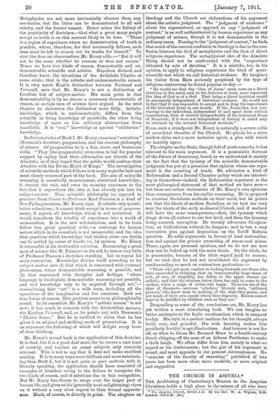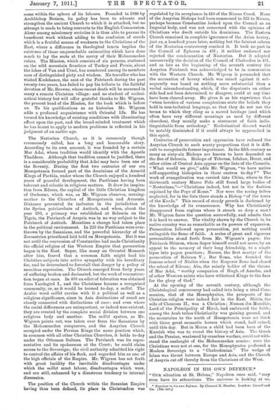THE CHURCH IN ASSYRIA.*
THE Archbishop of Canterbury's Mission to the Assyrian Christians holds a high place in the esteem of all who have Th. Asturian Church, 110-010 A.D. By the Rev, W. A. Wigram,
Toondoit; (513.]
come within the sphere of its labours. Founded in 1886 by Archbishop Benson, its policy has been to educate and strengthen the ancient Church to which it is attached, but no attempt is made to bring converts to the English Communion. Alone among missionary societies it is thus able to pursue its beneficent work without adding to the confusion of creeds which is a fruitful source of weakness to the Christians of the East, where a difference in theological tenets implies the existence of those unquenchable animosities which have done much to lay the sects at the mercy of their Mohammedan rulers. The Mission, which consists of six persons, stationed on the wild mountain frontiers of Turkey and Persia, about the lakes of Van and Ijrmi, has numbered among its members men of distinguished piety and wisdom. No traveller who has visited Kudshanes, the seat of the Patriarch during the past twenty-two years, has failed to pay his tribute to the faithful devotion of Mr. Browne, whose recent death will be mourned in many a remote Christian village : and no student of ecclesi- astical history but will offer grateful thanks to Mr. Wigram, the present head of the Mission, for the book which is before us. To his qualifications as an historian Mr. Wigram adds a profound acquaintance with Oriental life. He has turned his knowledge of existing conditions with illuminating effect upon the past, and the broad-minded treatment which he has learnt to apply to modern problems is reflected in. his judgment of an earlier age.
The Nestorian Church, as it is commonly though erroneously called, has a long and honourable story. According to its own account, it was founded by a certain Mar Adai, whom tradition would identify with the Apostle Thaddeus. Although that tradition cannot be justified, there is a considerable probability that Adai may have been one of the Seventy. During the first two centuries of our era Mesopotamia formed part of the dominions of the Arsacid Kings of Parthia, under whom the Church enjoyed a hundred years of peaceful development, the Parthians having been tolerant and eclectic in religious matters. It drew its inspira- tion from Edessa, the capital of the little Christian kingdom of Osrhoene, which was, as Mr. Wigram observes, nursing- mother to the Churches of Mesopotamia and Armenia. Distance prevented its inclusion in the jurisdiction of the Syrian patriarchate of Antioch, and when, about the year 280, a primacy was established at Seleucia on the Tigris, the Patriarch of Assyria was in no way subject to the Patriarch of Antioch. Meantime a change had taken place in the political environment. In 225 the Parthians were over- thrown by the Sasanians, and the powerful hierarchy of the Zoroastrian priesthood laid hold on Mesopotamia. But it was not until the conversion of Constantine had made Christianity the official religion of the Western Empire that persecution began in the East. Sapor, like many an Oriental Monarch after him, feared that a common faith might lead his Christian subjects into active sympathy with his hereditary foe, and he determined to forestall that danger by a policy of merciless repression. The Church emerged from forty years of suffering broken and decimated, but the work of reconstruc- tion began at once. In 409 an edict of toleration was obtained front Yazdegird I., and the Christians became a recognised community, or, as it would be termed to-day, a millet. The Arabic word millet carries with it a political as well as a religious significance, since in Asia distinctions of creed are closely connected with distinctions of race : and even where the racial differences are unimportant, or indeed non-existent, they are created by the complete social division between one religious body and another. The millet system, as Mr. Wigram points out, was taken over from the Sasanians by the Mohammedan conquerors, and the Assyrian Church occupied under the Persian Kings the same position which, in common with all other Christian Churches, it holds to-day under the Ottoman Sultans. The Patriarch was its repre- sentative and its spokesman at the Court; he could claim access to the Sovereign; the civil authority admitted his right to control the affairs of his flock, and regarded him as one of the high officials of the Empire. Mr. Wigram has set forth with great lucidity the inevitable disadvantages under which the millet must labour, disadvantages which were, and are still, enhanced by a disastrous tendency to internal dissensicn.
The position of the Church within the Sasanian Empire
• Napoleon in his own Defence. By Clement IC. Shorter. having thus been defined, its place in Christendom was co. 1128. net.]
regulated by its acceptance in 410 of the Nicene Creed. None of the Assyrian Bishops had been summoned in 325 to Nicaea, perhaps because Constantine looked upon the Council as an Imperial body, and was not concerned with the opinions of Christians who dwelt outside his dominions. The Eastern Church remained in complete ignorance of the Arian heresy, just as, a hundred years later, nothing but the faintest echoes of the Nestorian controversy reached it. It took no part in the Council of Ephesus in 431; it neither endorsed nor rejected the condemnation of Nestorius. But it adopted unreservedly the decision of the Council of Chalcedon in 451, and as late as the beginning of the seventh century the Assyrian Patriarch was acknowledged to be in communion with the Western Church. Mr. Wigratn is persuaded that the accusation of heresy which was raised against it sub- sequently was based on nothing more substantial than a verbal misunderstanding, which, if the disputants on either side had not been determined, to disagree, could at any time have been cleared away. He gives it as his experience that "when heretics of various complexions state the beliefs they hold in non-technical language, so that they do not use the terms to which they cling as a sacred heritage (and which often have very different meanings as used by different churches), they usually make a statement of faith indis- tinguishable from orthodoxy." Ecclesiastical discord would be notably diminished if it could always be approached in this spirit.
Centuries of persecution and oppression have reduced the Assyrian Church to such scanty proportions that it is diffi- cult to recognise its former importance. In the fifth century as many as sixty-six Bishops are known to have depended on the See of Selencia. Bishops of Teheran, Isfahan, Herat, and other cities of Central Asia appear on the lists of the Councils. "What would we give," adds Mr. Wigram, "to have native self-supporting bishoprics in those centres to-day ? " The work of evangelisation was carried into China, where in the thirteenth century Marco Polo still found large bodies of " Nestorians,"—" Christians indeed, but not in the fashion enjoined by the Pope of Rome." Nor were the roving tribes neglected, for in the lists there stands a Bishop "of the tents of the Kurds." This record of steady growth is darkened by the knowledge of its evanescence. Why has Christianity disappeared from regions where it struck so deep a root ? Mr. Wigram faces the question sorrowfully, and admits that it is hard to answer. The vitality shown by the Church in its native country was as remarkable as its powers of expansion. Persecution followed upon persecution, yet nothing could extinguish the flame of faith. A series of great and vigorous personalities stand forth from Mr. Wigram's pages : the Patriarch Shimun, whom Sapor himself could not move, by an appeal to the memory of their long friendship, to a single lapse into pagan practices ; Narses, the first martyr of the persecution of Bahrain V.; Bar Soma, who founded the famous school of Nisibis when the Emperor Zeno had closed the school of Edessa; Aba, the saintly holder of the throne of Mar Adai, "worthy companion of Hugh, of Anselm, and of other Western saints who have withstood Kings to the face for the glory of God."
At the opening of the seventh century, although the Christological controversy had called into being a rival Com- munion, that of the Monophysites, the prospects of the Christian religion were indeed fair in the East. Shirin, the wife of Chosroes II., was a Christian ; Numan ibn Mundhir, Lord of the Principality of Hirah, had embraced the faith ; among the Arab tribes Christianity was gaining ground, and the mountains to the north of Mesopotamia were set thick with those great monastic houses which stand, half ruined, until this day. But in Mecca a child had been born of the Kureish who was to recast the history of Asia. The Greek and the Persian, weakened by ceaseless warfare, could not with- stand the onslaught of the Mohammedan armies ; even the Christians were not at one, for the Monophysites preferred a Moslem Sovereign to a " Chalcedonian." The wedge of Islam was thrust between Europe and Asia, and the Church of Assyria cut off thereby from the Christians of the West.



















































 Previous page
Previous page